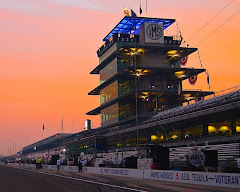
Three different drivers can win the 2009 IndyCar Series championship by winning and leading the most laps in the finale at Homestead-Miami Speedway. Needless to say that the battle between Scott Dixon, Dario Franchitti and Ryan Briscoe is tight. Unfortunately, it seems that the resulting tension among auto racing consumers in the United States is less than palpable.
Talented as they are, the championship contenders have failed to establish a fan base. Why?
Let's return to IndyCar Maxim #4. I quote renowned marketing and strategy professor Clayton Christensen.
"...the job, not the customer, is the fundamental unit of analysis for the marketer who hopes to develop a product that consumers will buy." - Prof. Clayton Christensen, Harvard Business SchoolFew consumers are buying the IndyCar racing product. I would suggest that the core problem is that the IRL has no clue about the "job" that prospective racing consumers want to get done.
Christensen continues:
"With few exceptions, every job people need or want to do has a social, functional, and emotional dimension."This insight is extremely important. The IndyCar product is the brainchild of IRL Racing Operations Division President Brian Barnhart. The former racing mechanic possesses significant expertise with regard to the functional aspects of the product. One suspects that the social and emotional product dimensions might sound to Barnhart like so much gobbledygook.
If that is the case, then perhaps Barnhart should take a glance at the grandstands and the Nielsen numbers. This is why the IRL needs an IndyCar Series product manager. Sales and racing operations do not begin to cover the activities that are necessary if IndyCar is to ever succeed in the competitive marketplace.
Not just an Audience, a TV Audience
IndyCar's failure to attract an audience on television is attributable to multiple factors. Some are easily identified. For example, night races are consistently outperformed by daytime events. Viewership for at least three of the IRL's established oval events has declined as more road and street races - and therefore more international road racing drivers - have been added.
The IndyCar schedule is inconsistent, confused and arbitrary. Fans of NASCAR and Formula 1 know exactly what they can expect when they watch a race. IndyCar is hopelessly muddled - a predominantly road and street racing series that includes almost exclusively road racing drivers and that happens to include the world's most famous oval race. The schedule is a non-strategic amalgamation of events for which promoters will pay and teams will show up.
The cars and events are managed. The product is not.
NASCAR has mastered what sociologists call parasocial interaction: a relationship between two individuals in which only one is actively engaged. In the case of NASCAR, that individual is the fan. The object of the parasocial relationship is the driver. This is not the same as living vicariously through another. Parasocial interaction in NASCAR is about the fan perceiving that he or she and the driver share certain life experiences and values.
Interestingly, psychologists suggest that parasocial actors tend to be more solitary and detached than others. Watching racing on television is by definition a solitary activity. Yes, some watch in large gatherings, but most tend to view races either alone or in the company of immediate family. Therefore, those who tend to engage in parasocial relationships would seem to be outstanding candidates to watch racing - and they do watch NASCAR racing - week after week.
Conversely, fans who attend IndyCar street races are commonly believed to be seeking a vibrant and interactive social setting. They are therefore not interested in parasocial relations. Is it any wonder that few of them are willing to sit alone, watching an IndyCar race, when they are not actually attending the event?

NASCAR has a consistent culture that tends to attract natural television viewers. IndyCar has a variable and often contradictory culture that appeals to few who are likely to watch races on TV.
More Questions
Racing fans who like the kind of racing that produced Scott Dixon, Dario Franchitti and Ryan Briscoe are not likely to watch a lot of racing on television. In addition, fans who might want to have parasocial relationships with IndyCar drivers are not likely able to do so because the fans and the drivers lack the types of shared life experiences upon which parasocial involvement is established.
The IRL is fond of showing its drivers participating in other sporting activities that they enjoy. Unfortunately, this typically entails some type of soccer, rugby or Australian Rules event. This is a waste of time because it says to the parasocial prospect, "You're right. These guys really are nothing like you. They're interested only in things that you don't care about."
Parasocial relations are essential in sports for which the players do not wear jerseys that identify their home city or school. Fans who lack a home team are event-goers. In that, there is no inherent harm.
Just don't expect them to look for your product on television. And don't be surprised when a tight championship battle fails to induce tension.
Roggespierre


 Dario Franchitti and Scott Dixon are two of the biggest stars in IndyCar. Unfortunately, in the greater sports entertainment marketplace, they are not stars at all. IndyCar is not a competitive product, and one reason is that Franchitti and Dixon are not competitive with Tony Stewart and Jimmie Johnson, Tiger Woods and Phil Mickelson, Venus and Serena Williams, and so on.
Dario Franchitti and Scott Dixon are two of the biggest stars in IndyCar. Unfortunately, in the greater sports entertainment marketplace, they are not stars at all. IndyCar is not a competitive product, and one reason is that Franchitti and Dixon are not competitive with Tony Stewart and Jimmie Johnson, Tiger Woods and Phil Mickelson, Venus and Serena Williams, and so on.
